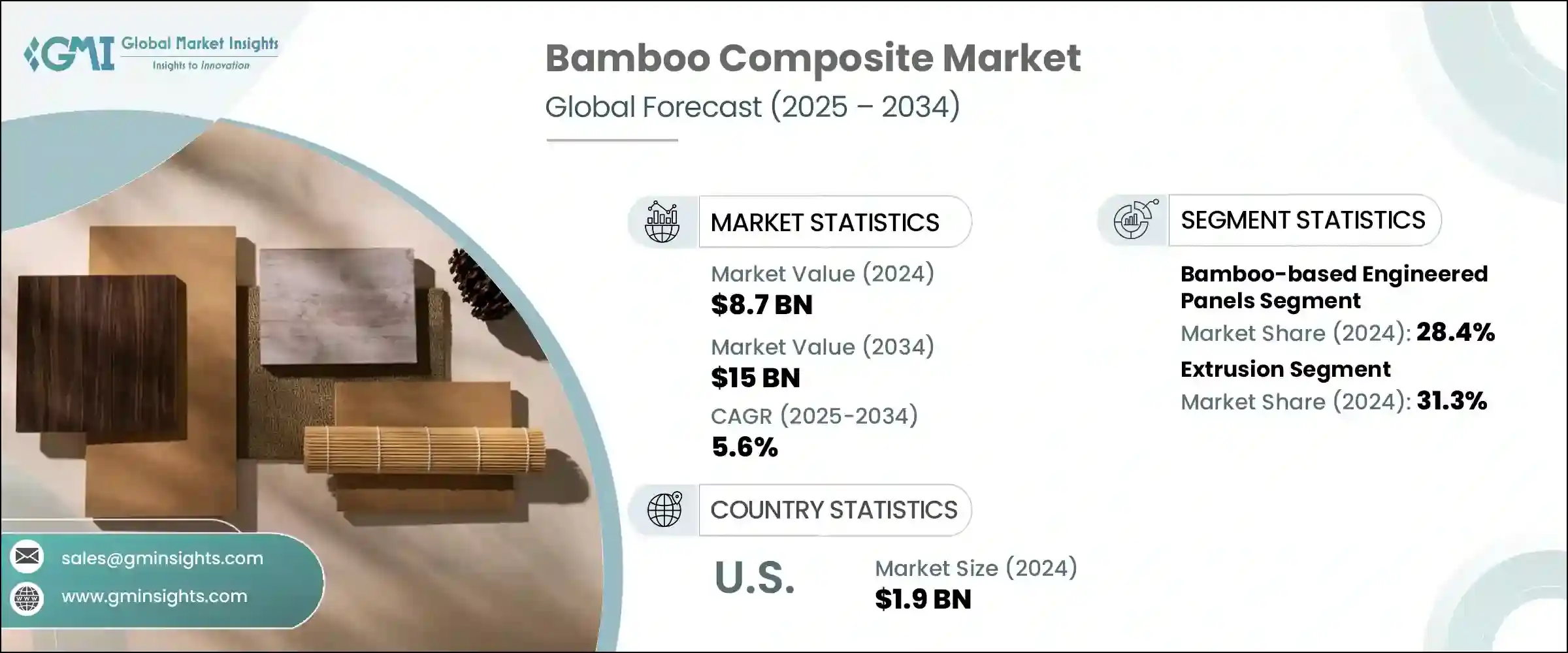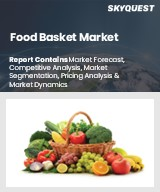
|
시장보고서
상품코드
1773326
대나무 복합재 시장 기회, 성장 촉진요인, 산업 동향 분석 및 예측(2025-2034년)Bamboo Composite Market Opportunity, Growth Drivers, Industry Trend Analysis, and Forecast 2025 - 2034 |
||||||
세계의 대나무 복합재 시장은 2024년에는 87억 달러로 평가되었으며 CAGR 5.6%를 나타내 2034년에는 150억 달러에 이를 것으로 추정됩니다.
대나무 복합재의 매력이 높아지고 있는 것은 그 환경 친화적인 성질과 강력한 기계적 성능에 기인하고 있어, 기존의 건축 재료를 대신하는 매력적인 선택이 되고 있습니다. 이러한 복합재는 대나무 섬유를 시멘트나 폴리머와 같은 결합 제제와 조합하여 만들어져 환경에 미치는 영향을 최소화한 재생 가능한 고성능 재료가 됩니다.

재생 가능한 자원과 환경 보호를 추진하는 세계의 이니셔티브는 대나무의 재배와 이용을 장려하고 있습니다. 또, 지속 가능한 농업과 이산화탄소의 회수를 추진하는 강력한 정부 지원 프로그램도, 대나무 복합재 산업의 성장에 공헌하고 있습니다. 이후에도 쇠퇴하지 않기 때문에 건설중도 건설 후에도 장기간에 걸쳐 환경에 혜택을 가져옵니다. 그 결과, 보다 환경친화적인 인프라나 저배출 건축자재를 요구하는 움직임은 건설, 가구, 인프라 등의 업계 전체에서 대나무 복합재에의 큰 관심을 일으키고 있습니다.
| 시장 범위 | |
|---|---|
| 시작 연도 | 2024년 |
| 예측 연도 | 2025-2034년 |
| 시작 금액 | 87억 달러 |
| 예측 금액 | 150억 달러 |
| CAGR | 5.6% |
2024년에는 대나무 기반의 인공 패널 부문이 28.4%의 점유율을 차지했습니다. 이 패널은 가구, 바닥, 장식 인테리어 등 다목적 용도로 인기를 얻고 있습니다. 구조적 강도와 미적 매력을 겸비하는 것으로, 그린 빌딩의 대처에 특히 적합합니다. 이산화탄소 배출량이 적기 때문에 지속가능성 목표와 인증기준에 부합하고 있습니다. 내구성과 자연스러운 외관을 겸비하고 있기 때문에 상업용과 주택용 양쪽 모두의 인테리어 용도에 매력적입니다.
2024년 압출 성형 부문의 점유율은 31.3%로 대나무 복합재의 생산 방법으로 가장 널리 사용되었습니다. 이 방법은 균일한 복합재 프로파일을 연속적으로 생산할 수 있기 때문에 확장성이 높고 자원 효율이 높습니다. 길고 균질한 대나무 부재를 생산할 수 있으므로 울타리, 갑판, 외장재 등 옥외 용도에 적합합니다. 압출 성형은 재료의 낭비를 최소화하면서 표면의 질감, 밀도 및 마무리를 정확하게 제어할 수 있으며 실외 성능에 필수적인 요소입니다. 습기, 자외선 노출 및 휨에 대한 내성은 압출 성형 기반 복합재가 가혹한 환경 조건에 적합하다는 것을 더욱 뒷받침합니다.
2024년 미국의 대나무 복합재 시장 규모는 19억 달러였습니다. 저탄소 재료의 채용이 진행되고 있습니다. 탄소 삭감에 대한 연방 정부와 주 수준의 인센티브가 그린 인프라로 시장의 이행을 가속화하고 있습니다.
세계의 대나무 복합재 시장 주요 기업은 Smith &Fong, Moso International BV, Dasso Group, Greenlam Industries, Teragren 등이 있습니다. 대나무 복합재 업계 시장 리더는 시장에서의 지위를 강화하기 위해 혁신과 지속가능성을 중시한 전략을 조합하여 채용하고 있습니다. 내구성, 내후성, 미적 유연성을 강화한 차세대 대나무 복합재를 개발하기 위해 연구개발에 투자하고 있습니다.
생산과 조달의 현지화는 국내 공급 체인을 지원하면서 물류 비용과 이산화탄소 배출량을 줄이는 데 도움이 되고 있습니다.
목차
제1장 조사 방법과 범위
제2장 주요 요약
제3장 업계 인사이트
- 생태계 분석
- 공급자의 상황
- 이익률
- 각 단계에서의 부가가치
- 밸류체인에 영향을 주는 요인
- 파괴적 혁신
- 업계에 미치는 영향요인
- 성장 촉진요인
- 업계의 잠재적 위험 및 과제
- 시장 기회
- 성장 가능성 분석
- 규제 상황
- 북미
- 유럽
- 아시아태평양
- 라틴아메리카
- 중동 및 아프리카
- Porter's Five Forces 분석
- PESTEL 분석
- 가격 동향
- 지역별
- 복합 유형별
- 향후 시장 동향
- 기술과 혁신의 상황
- 현재의 기술 동향
- 신흥기술
- 특허 상황
- 무역 통계(HS코드)(참고 : 무역 통계는 주요 국가에서만 제공됨)
- 주요 수입국
- 주요 수출국
- 지속가능성과 환경 측면
- 지속가능한 관행
- 폐기물 감축 전략
- 생산에 있어서의 에너지 효율
- 환경 친화적인 노력
- 탄소발자국의 고려
제4장 경쟁 구도
- 서론
- 기업의 시장 점유율 분석
- 지역별
- 북미
- 유럽
- 아시아태평양
- 라틴아메리카
- 중동 및 아프리카
- 지역별
- 기업 매트릭스 분석
- 주요 시장 기업의 경쟁 분석
- 경쟁 포지셔닝 매트릭스
- 주요 발전
- 합병과 인수
- 파트너십 및 협업
- 신제품 발매
- 확장 계획
제5장 시장 추계·예측 : 구성 요소 유형별(2021-2034년)
- 주요 동향
- 대나무-플라스틱 복합재(BPC)
- 대나무-폴리에틸렌 복합재
- 대나무-폴리프로필렌 복합재
- 대나무-PVC 복합재
- 기타
- 대나무 섬유 강화 복합재
- 대나무-에폭시 복합재
- 대나무-폴리에스테르 복합재
- 대나무-비닐 에스테르 복합재
- 기타
- 대나무 기반 엔지니어링 패널
- 대나무 합판
- 대나무 파티클 보드
- 대나무 지향 스트랜드 보드
- 대나무 중간 밀도 섬유판
- 대나무 시멘트 복합재
- 대나무-세라믹 복합재
- 기타
제6장 시장 추계·예측 : 제조 방법별(2021-2034년)
- 주요 동향
- 압출
- 압축 성형
- 사출 성형
- 핸드 레이업
- 수지 이송 성형
- 기타
제7장 시장 추계·예측 : 용도별(2021-2034년)
- 주요 동향
- 구조 부품
- 보 및 기둥
- 패널 및 보드
- 보강재
- 바닥 및 데크
- 실내 바닥
- 야외 데크
- 타일 및 판재
- 자동차 부품
- 내부 부품
- 외장 부품
- 구조 부품
- 가구 및 캐비닛
- 주거용 가구
- 업무용 가구
- 주방 캐비닛
- 소비재
- 가정용품
- 전자기기의 케이스
- 스포츠 및 레저 장비
- 기타
제8장 시장 추계·예측 : 최종 이용 산업별(2021-2034년)
- 주요 동향
- 건축 및 건설
- 주택건설
- 상업건설
- 인프라 개발
- 자동차
- 승용차
- 상용차
- 전기자동차
- 가구 및 인테리어 디자인
- 주거용 가구
- 업무용 가구
- 접객 및 조직
- 소비재
- 홈 액세서리
- 일렉트로닉스
- 포장
- 해양
- 보트 건조
- 해양 인프라
- 기타
제9장 시장 추계·예측 : 지역별(2021-2034년)
- 주요 동향
- 북미
- 미국
- 캐나다
- 유럽
- 독일
- 영국
- 프랑스
- 스페인
- 이탈리아
- 아시아태평양
- 중국
- 인도
- 일본
- 호주
- 한국
- 라틴아메리카
- 브라질
- 멕시코
- 아르헨티나
- 중동 및 아프리카
- 사우디아라비아
- 남아프리카
- 아랍에미리트(UAE)
제10장 기업 프로파일
- Bamboo Living
- Dasso Group
- EcoPlanet Bamboo
- Greenlam Industries
- Moso International BV
- Smith &Fong
- Teragren
- Xingli Bamboo Products
- Zhejiang Yongyu Household
The Global Bamboo Composite Market was valued at USD 8.7 billion in 2024 and is estimated to grow at a CAGR of 5.6% to reach USD 15 billion by 2034. The rising appeal of bamboo composites stems from their eco-friendly nature and strong mechanical performance, making them a compelling alternative to conventional construction materials. These composites are created by combining bamboo fibers with binding agents like cement or polymers, resulting in a renewable, high-performance material with minimal environmental impact. Bamboo's rapid growth-some species grow nearly 91 centimeters in just one day-makes it an ideal candidate for mass-scale sustainable production.

Global initiatives promoting renewable resources and environmental protection continue to encourage bamboo cultivation and utilization. Strong government-backed programs promoting sustainable agriculture and carbon capture are also contributing to the bamboo composite industry's growth. Bamboo's carbon-storing capabilities do not diminish after harvest, offering long-term environmental benefits during and after construction. As a result, the push for greener infrastructure and low-emission construction materials continues to drive significant interest in bamboo composites across industries such as construction, furniture, and infrastructure.
| Market Scope | |
|---|---|
| Start Year | 2024 |
| Forecast Year | 2025-2034 |
| Start Value | $8.7 Billion |
| Forecast Value | $15 Billion |
| CAGR | 5.6% |
In 2024, the bamboo-based engineered panels segment represented a 28.4% share. These panels have gained popularity due to their versatile applications in furniture, flooring, and decorative interiors. Their combination of structural strength and aesthetic appeal makes them especially suitable for green building initiatives. Since they carry a low carbon footprint, they align well with sustainability goals and certification standards. Their durability, combined with a natural appearance, makes them attractive for both commercial and residential interior applications.
The extrusion segment accounted for 31.3% share in 2024, becoming the most widely used production method for bamboo composites. This method allows continuous output of uniform composite profiles, making it highly scalable and resource efficient. Its ability to produce long, homogeneous bamboo components is well-suited for outdoor uses such as fencing, decking, and exterior cladding. The extrusion process helps minimize material waste while allowing for precise control over surface texture, density, and finish-critical elements for outdoor performance. Resistance to moisture, UV exposure, and warping further boosts the suitability of extrusion-based composites for harsh environmental conditions.
United States Bamboo Composite Market was valued at USD 1.9 billion in 2024. The country's leadership position is supported by a strong push for sustainable construction practices and widespread adoption of eco-certified materials. Bamboo-based composites are gaining ground in various applications, from structural panels and cabinetry to flooring and decking. Public and private sectors alike are embracing low-carbon materials to align with environmental goals. Federal and state-level incentives for carbon reduction have accelerated the market's transition toward green infrastructure. In addition, consumers are becoming increasingly conscious of product sustainability throughout the life cycle, boosting demand for bamboo alternatives in remodeling and home improvement projects.
Leading companies operating in the Global Bamboo Composite Market include Smith & Fong, Moso International B.V., Dasso Group, Greenlam Industries, and Teragren. Market leaders in the bamboo composite industry are adopting a mix of innovation and sustainability-focused strategies to strengthen their market position. These companies are investing in R&D to create next-generation bamboo composites with enhanced durability, weather resistance, and aesthetic flexibility. Many are entering strategic partnerships with construction and interior design firms to broaden application scopes.
Localization of production and sourcing helps them reduce logistics costs and carbon emissions while supporting domestic supply chains. Firms are also working toward international green certifications to appeal to environmentally conscious customers. Brand differentiation through product customization and innovation in manufacturing techniques, such as advanced extrusion, help companies penetrate premium market segments and secure long-term growth.
Table of Contents
Chapter 1 Methodology & Scope
- 1.1 Market scope and definition
- 1.2 Research design
- 1.2.1 Research approach
- 1.2.2 Data collection methods
- 1.3 Data mining sources
- 1.3.1 Global
- 1.3.2 Regional/Country
- 1.4 Base estimates and calculations
- 1.4.1 Base year calculation
- 1.4.2 Key trends for market estimation
- 1.5 Primary research and validation
- 1.5.1 Primary sources
- 1.6 Forecast model
- 1.7 Research assumptions and limitations
Chapter 2 Executive Summary
- 2.1 Industry 360° synopsis
- 2.2 Key market trends
- 2.2.1 Component type
- 2.2.2 Manufacturing method
- 2.2.3 Application
- 2.2.4 End use industry
- 2.2.5 Regional
- 2.3 TAM Analysis, 2025-2034
- 2.4 CXO perspectives: Strategic imperatives
- 2.4.1 Executive decision points
- 2.4.2 Critical success factors
- 2.5 Future Outlook and Strategic Recommendations
Chapter 3 Industry Insights
- 3.1 Industry ecosystem analysis
- 3.1.1 Supplier landscape
- 3.1.2 Profit margin
- 3.1.3 Value addition at each stage
- 3.1.4 Factor affecting the value chain
- 3.1.5 Disruptions
- 3.2 Industry impact forces
- 3.2.1 Growth drivers
- 3.2.2 Industry pitfalls and challenges
- 3.2.3 Market opportunities
- 3.3 Growth potential analysis
- 3.4 Regulatory landscape
- 3.4.1 North America
- 3.4.2 Europe
- 3.4.3 Asia Pacific
- 3.4.4 Latin America
- 3.4.5 Middle East & Africa
- 3.5 Porter's analysis
- 3.6 PESTEL analysis
- 3.6.1 Technology and Innovation landscape
- 3.6.2 Current technological trends
- 3.6.3 Emerging technologies
- 3.7 Price trends
- 3.7.1 By region
- 3.7.2 By composite type
- 3.8 Future market trends
- 3.9 Technology and Innovation landscape
- 3.9.1 Current technological trends
- 3.9.2 Emerging technologies
- 3.10 Patent Landscape
- 3.11 Trade statistics (HS code) ( Note: the trade statistics will be provided for key countries only )
- 3.11.1 Major importing countries
- 3.11.2 Major exporting countries
- 3.12 Sustainability and environmental aspects
- 3.12.1 Sustainable practices
- 3.12.2 Waste reduction strategies
- 3.12.3 Energy efficiency in production
- 3.12.4 Eco-friendly initiatives
- 3.13 Carbon footprint consideration
Chapter 4 Competitive Landscape, 2024
- 4.1 Introduction
- 4.2 Company market share analysis
- 4.2.1 By region
- 4.2.1.1 North America
- 4.2.1.2 Europe
- 4.2.1.3 Asia Pacific
- 4.2.1.4 LATAM
- 4.2.1.5 MEA
- 4.2.1 By region
- 4.3 Company matrix analysis
- 4.4 Competitive analysis of major market players
- 4.5 Competitive positioning matrix
- 4.6 Key developments
- 4.6.1 Mergers & acquisitions
- 4.6.2 Partnerships & collaborations
- 4.6.3 New Product Launches
- 4.6.4 Expansion Plans
Chapter 5 Market Estimates and Forecast, By Component Type, 2021–2034 (USD Billion) (Kilo Tons)
- 5.1 Key trends
- 5.2 Bamboo-plastic composites (BPC)
- 5.2.1 Bamboo-polyethylene composites
- 5.2.2 Bamboo-polypropylene composites
- 5.2.3 Bamboo-PVC composites
- 5.2.4 Others
- 5.3 Bamboo-fiber reinforced composites
- 5.3.1 Bamboo-epoxy composites
- 5.3.2 Bamboo-polyester composites
- 5.3.3 Bamboo-vinyl ester composites
- 5.3.4 Others
- 5.4 Bamboo-based engineered panels
- 5.4.1 Bamboo plywood
- 5.4.2 Bamboo particleboard
- 5.4.3 Bamboo oriented strand board
- 5.4.4 Bamboo medium density fiberboard
- 5.5 Bamboo-cement composites
- 5.6 Bamboo-ceramic composites
- 5.7 Others
Chapter 6 Market Estimates and Forecast, By Manufacturing Method, 2021–2034 (USD Billion) (Kilo Tons)
- 6.1 Key trends
- 6.2 Extrusion
- 6.3 Compression moulding
- 6.4 Injection moulding
- 6.5 Hand lay-up
- 6.6 Resin transfer moulding
- 6.7 Others
Chapter 7 Market Estimates and Forecast, By Application, 2021–2034 (USD Billion) (Kilo Tons)
- 7.1 Key trends
- 7.2 Structural components
- 7.2.1 Beams and columns
- 7.2.2 Panels and boards
- 7.2.3 Reinforcement materials
- 7.3 Flooring and decking
- 7.3.1 Indoor flooring
- 7.3.2 Outdoor decking
- 7.3.3 Tiles and planks
- 7.4 Automotive components
- 7.4.1 Interior components
- 7.4.2 Exterior components
- 7.4.3 Structural parts
- 7.5 Furniture and cabinetry
- 7.5.1 Residential furniture
- 7.5.2 Commercial furniture
- 7.5.3 Kitchen cabinetry
- 7.6 Consumer goods
- 7.6.1 Household products
- 7.6.2 Electronics casings
- 7.6.3 Sports and leisure equipment
- 7.7 Others
Chapter 8 Market Estimates and Forecast, By End Use Industry, 2021–2034 (USD Billion) (Kilo Tons)
- 8.1 Key trends
- 8.2 Building and construction
- 8.2.1 Residential construction
- 8.2.2 Commercial construction
- 8.2.3 Infrastructure development
- 8.3 Automotive
- 8.3.1 Passenger vehicles
- 8.3.2 Commercial vehicles
- 8.3.3 Electric vehicles
- 8.4 Furniture and interior design
- 8.4.1 Residential furniture
- 8.4.2 Commercial furniture
- 8.4.3 Hospitality and institutional
- 8.5 Consumer goods
- 8.5.1 Home accessories
- 8.5.2 Electronics
- 8.5.3 Packaging
- 8.6 Marine
- 8.6.1 Boat building
- 8.6.2 Marine infrastructure
- 8.7 Others
Chapter 9 Market Estimates and Forecast, By Region, 2021–2034 (USD Billion) (Kilo Tons)
- 9.1 Key trends
- 9.2 North America
- 9.2.1 U.S.
- 9.2.2 Canada
- 9.3 Europe
- 9.3.1 Germany
- 9.3.2 UK
- 9.3.3 France
- 9.3.4 Spain
- 9.3.5 Italy
- 9.4 Asia Pacific
- 9.4.1 China
- 9.4.2 India
- 9.4.3 Japan
- 9.4.4 Australia
- 9.4.5 South Korea
- 9.5 Latin America
- 9.5.1 Brazil
- 9.5.2 Mexico
- 9.5.3 Argentina
- 9.6 Middle East and Africa
- 9.6.1 Saudi Arabia
- 9.6.2 South Africa
- 9.6.3 UAE
Chapter 10 Company Profiles
- 10.1 Bamboo Living
- 10.2 Dasso Group
- 10.3 EcoPlanet Bamboo
- 10.4 Greenlam Industries
- 10.5 Moso International B.V.
- 10.6 Smith & Fong
- 10.7 Teragren
- 10.8 Xingli Bamboo Products
- 10.9 Zhejiang Yongyu Household



















